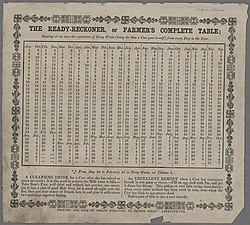
A ready reckoner is a printed book or table containing pre-calculated values, often multiples of given amounts. They were widely used in shops and by tradesmen before the advent of cheap electronic calculators, metric weights and measures and decimal currencies in the 1970s.
Background
Before the 1960s and the widespread introduction of calculators, multiplication was a laborious chore, often prone to error. This was especially so when calculations involved non-decimal currencies or weights and measures. Various devices were invented to aid this process, such as the abacus, log tables, slide rule, stepped reckoner, or the comptometer, but the most commonly used device for everyday commerce was the ready reckoner. These could be either general-purpose – aimed to meet the needs of a variety of trades – or designed specifically for one trade or group of trades.
History
The earliest surviving ready reckoner in English dates from the 1570s; other sources attribute the invention to the Dutch mathematician Simon Stevin, who calculated and published decimal tables in the 1580s. William Webster published A plaine and most necessarie booke of tables, for simple and compound interest, in 1625. There are several other seventeenth-century publications giving 'reckonings ready done' or 'accounts ready cast up' or tables of simple and compound interest. The most popular of these was William Leybourn's, Panarithmologia, being a mirror breviate treasure mate for merchants, bankers, tradesmen, mechanicks, and a sure guide for purchasers, sellers, or mortgagers of land, leases, annuities, rents, pensions, &c. in present possession or reversion. (1693). Other works were published in France such as François Barrême's Le Livre des Comptes Faits. Paris: Thierry, which appeared in 1673, and was still being published in 1862.
The term 'ready reckoner' was coined by the schoolmaster Daniel Fenning with the publication of The ready reckoner; or trader's most useful assistant in 1757. This was a modernised and extended version of Leybourn's work, which was reprinted in Boston, Massachusetts, about 1770, and translated into German in Germantown, Philadelphia, 1774. Fenning's work continued to be reprinted in England until the early 1820s when several of the tables were superseded by the advent Imperial Weights and Measures under the Weights and Measures Act 1824 (5 Geo. 4. c. 74).

By the end of the eighteenth century, ready reckoners designed for the needs of particular trades or types of business began to appear. Thus The gentleman and farmers' assistant, by John Cullyer (1795) or The farmer's, grazier's, and butcher's ready reckoner (1796).
Hundreds of ready reckoners appeared, principally in the UK and US throughout the nineteenth century and the first half of the twentieth century, as they proved to be cheaper to produce and easier to use than alternative means of calculation. According to Williams and Johnson, 'Ready Reckoners were the dominant aid used for multiplication in trade from 1800 to 1950. Throughout this period their sales far exceeded any other calculating aid used in trade to assist in making routine calculations.' It was only with the gradual introduction of mechanical and later electronic calculators that they began to be superseded.
Notes
- ^ Williams & Johnson 2005, p. 64.
- ESTC S112011
- Ore 1988, p. 326.
- ESTC S95754
- Raven 2014, p. 194.
- Rance 2009, p. 2.
- ESTC W508308, and W19354
- Williams & Johnson 2005, p. 77.
References
- "English Short Title Catalogue (ESTC)".
- Ore, Oystein (1988). Number theory and its history. New York: Dover. ISBN 0-486-65620-9.
- Rance, David G. (2009). "Reckon on it! A very British trait" (PDF). IM 2009. 15th International Meeting of Slide Rule Collectors. Grunewald. p. 2.
- Raven, James (2014). Publishing business in eighteenth-century England. Woodbridge: Economic History Society/Boydell Press. ISBN 978-1-84383-910-1.
- Williams, Bruce O. B.; Johnson, Roger G. (2005). "Ready Reckoners". IEEE Annals of the History of Computing. 27 (4): 64–80. ISSN 1058-6180.